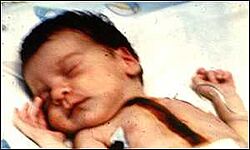Baby Fae facts for kids
Stephanie Fae Beauclair (born October 14, 1984 – died November 15, 1984), known to many as Baby Fae, was a baby girl born in 1984. She had a serious heart problem called hypoplastic left heart syndrome, which means the left side of her heart wasn't fully developed.
Baby Fae became famous for being the first baby to receive a xenotransplant procedure. This is when an organ from one species is transplanted into another. She received the heart of a baboon. Even though she lived for only 21 days after the surgery, she survived much longer than anyone else had with a non-human heart at that time. Her case helped doctors learn a lot about heart transplants.
The Groundbreaking Surgery
The special surgery was done by Dr. Leonard Lee Bailey at Loma Linda University Medical Center. The operation itself was successful. However, Baby Fae died 21 days later because her body's immune system started to reject the new heart. This is called transplant rejection.
Doctors believed the rejection happened because Baby Fae had type O blood, and the baboon heart was type AB. Her body created special defenses (antibodies) against the different blood type. Finding a baboon with type O blood was very difficult, so the doctors had to use a type AB heart.
A baboon heart was used because there wasn't enough time to find a human heart that would be a good match for Baby Fae. Doctors hoped they could replace the baboon heart with a human heart later on. But they couldn't find a suitable human donor in time. Before Baby Fae, no infant heart transplant, even with human hearts, had been successful. This was often because there weren't enough tiny human hearts available.
Dr. Bailey had spent years researching how to do cross-species heart transplants. He had performed over 150 transplants in animals like sheep, goats, and baboons. Baby Fae's survival, even for 21 days, was a major step forward. She lived two weeks longer than any previous person who had received a non-human heart.
Important Questions and Lessons
Baby Fae's surgery led to many important discussions about what is right and wrong in medicine. These discussions are part of medical ethics. People wondered if parents should be allowed to let their children have experimental surgeries. They also questioned if Baby Fae's parents were given all the information they needed before agreeing to the procedure.
The case also made doctors think about how much risk is acceptable in new medical treatments. A writer named Charles Krauthammer called Baby Fae's case "an adventure in medical ethics." Even though there were debates, the attention from Baby Fae's case helped Dr. Bailey perform the first successful human heart transplant in a baby just one year later.
The American Medical Association and other medical groups later said that animal-to-human transplants should only be done as part of careful research. This research should have clear rules and controls. Baby Fae's full name was kept private at the time of her surgery. However, her mother decided to share it in 1997.
See also
- Boyd Rush, 1964 recipient of the first heart transplant, which was taken from a chimpanzee
- Louis Washkansky, 1967 recipient of the first human heart transplant
- David Bennett Sr., 2022 recipient of a genetically modified pig heart transplant.


